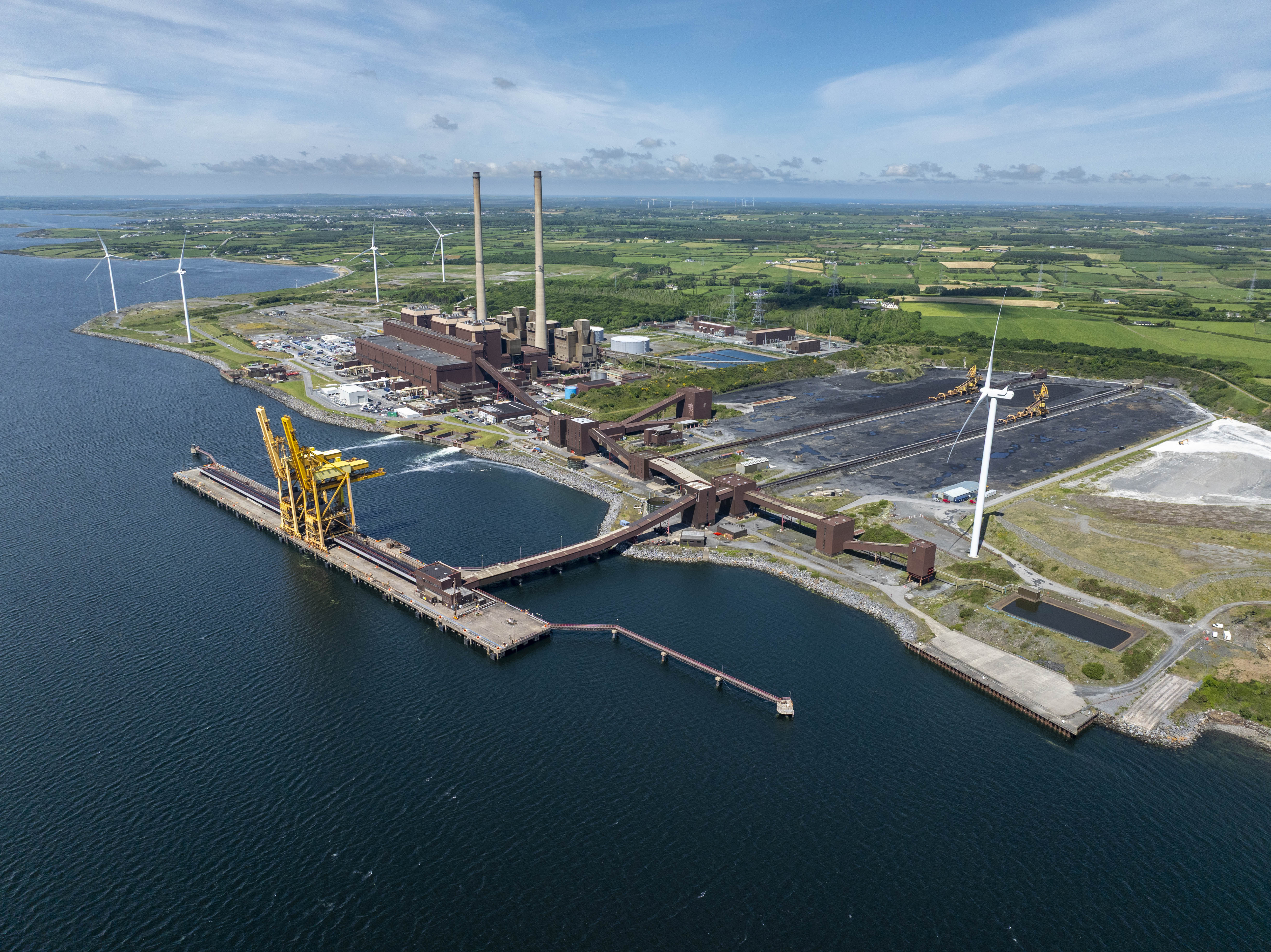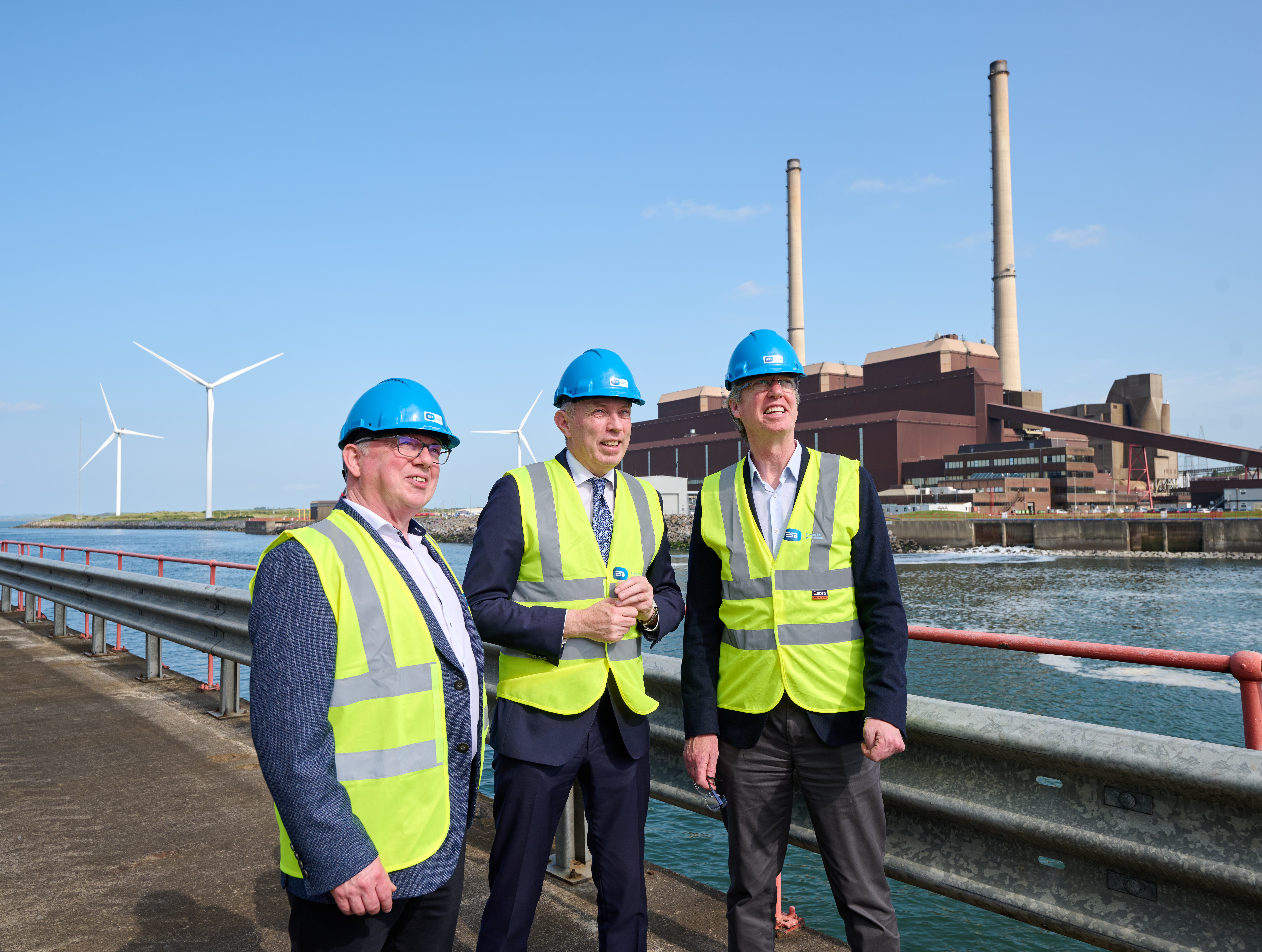Having used coal for the last time in June 2025, Moneypoint Power Station in Co Clare is gearing up for an exciting new chapter: as a renewable energy hub enabling Ireland’s net zero future.
A striking view greets you on the approach to Moneypoint along the coast road from Kilrush in Co Clare. On the right, the waters of the Shannon Estuary and the rolling Kerry countryside beyond. On the left, a scene of old worlds meeting new, as wind turbines turn against the backdrop of Ireland’s last coal-fired generation station.
Moneypoint has been a powerhouse of the Irish electricity system since its construction in 1985. For years it was the largest single generator in the country, delivering energy to homes and businesses almost 300km away in Dublin via a cross-country highway of high-voltage cables. “We may be physically in Clare, but electrically we’re in Dublin,” as station manager Stephen O’Mahoney puts it.
Now, 40 years later, Moneypoint is entering a new chapter in its history. In late June 2025, the plant stopped using coal entirely. For the next few years, it will run exclusively on oil – a much less carbon-intensive fuel – and will only operate when called upon as a back-up should there be a shortage in supply on the Irish grid. The long-term vision for the almost 500-acre site is to transform it into one of Ireland’s largest green energy hubs, helping the country move away from fossil fuels by unlocking home-grown offshore wind power.

Aerial shot of Moneypoint station on the coast of Co Clare - the 330m long jetty was built to accommodate coal shipments, but in future could support offshore wind farm operation
Looking back
The origins of Moneypoint date back to the oil crisis of the 1970s. With Ireland almost totally dependent on oil at the time, an alternative was needed to ensure energy security. As Stephen explains: “It was decided that a coal-fired power plant would not only give fuel diversity but also enable longer-term fuel storage. By the time it was built the plant was supplying on average 25% of the nation's electricity – with a coal store that could keep three months’ worth of fuel readily available.”
A number of factors made Moneypoint ideally suited for a plant like this. The Shannon Estuary provides a natural deepwater port – the deepest in Europe after Rotterdam – necessary for the large coal vessels to dock. Add to this the strong rock foundations characteristic of the area and the ready availability of water from the estuary for cooling, and the site was an obvious choice. The station began generating in 1985 with a capacity of 915MW: almost one-sixth of Ireland’s current peak demand of electricity.
The immense scale of the plant infrastructure is a testament to how critical coal generation was for Ireland at the time. The deepwater jetty is around 330 metres in length, allowing docking of vessels carrying typical loads of 180,000 tonnes, with shipments arriving every three weeks when the station was running at full tilt. An intricate system of conveyor belts transported the coal from the pier through stores up to the coal yard.
During the original construction the plant was fitted with two oil storage tanks with a capacity of 50,000 tonnes, for use as a back-up if needed. Now, these will become the main fuel store of the plant as it enters its next transitional phase.
Looking forward
Turning to the immediate future, ESB and EirGrid have signed an agreement to keep Moneypoint available to generate on oil from 2025 to 2029, if the electricity system experiences shortness – part of a suite of measures introduced by the Commission for Regulation of Utilities to enhance the security of Ireland’s electricity supply. “Oil has a number of benefits over coal,” explains Stephen. “It’s less carbon intensive, it doesn’t produce ash or dust, and it’s easier to handle and store which makes it more reliable as a back-up fuel.”

Picture: (left to right) Moneypoint Plant Manager Stephen O'Mahoney with Minister of State Timmy Dooley and ESB Chief Executive Paddy Hayes at the power plant on the day when ESB announced the end of coal generation.
Moneypoint commenced its transition away from fossil fuel generation on site in 2017 with the construction of a 17MW onshore wind farm. In 2021, we announced Green Atlantic @ Moneypoint, an ambitious plan to transform the site into one of the country’s largest renewable energy hubs. Phase one of this plan was completed in 2022 with a €50 million investment in Ireland’s first synchronous compensator, a zero-carbon technology that allows the system to utilise ever increasing amounts of renewable electricity.
The site also offers great potential for the development and operation of offshore wind farms, which will be crucial for Ireland to meet its climate goals. “The deep-water port and other infrastructure that was so important for coal generation is also really useful for offshore,” explains Stephen. “There is a long shorefront where turbine blades could be docked, space with potential for a facility to manufacture the concrete bases, and a large area quayside where floating turbines could be assembled before towing them offshore.”
Further plans are for the old coal yard to be used for a peaking plant, which could run initially on hydrogenated vegetable oil (HVO) and subsequently on low-carbon fuels, to provide security of supply during the transition to renewable energy. This would be complemented by a long-duration energy storage facility, located alongside the thermal plant.
Longer term, there is huge potential for excess offshore wind energy to power production of zero-carbon fuels like green hydrogen or ammonia. ESB is exploring the possibility of such an electrolysis facility at Moneypoint. “Massive offshore wind, backed up by batteries and zero-carbon dispatchable generation running on hydrogen – green hydrogen we produce here on site from excess wind electricity,” explains Stephen. “That’s a really exciting long-term vision for transforming our site, which could deliver clean energy to millions of customers and bring jobs and investment here locally.”
While the details are not yet set in stone, one thing is certain: the end of coal generation is just the beginning for Moneypoint’s journey.
Read more about ESB’s net zero strategy.
Read the press release announcing the cessation of use of coal.
